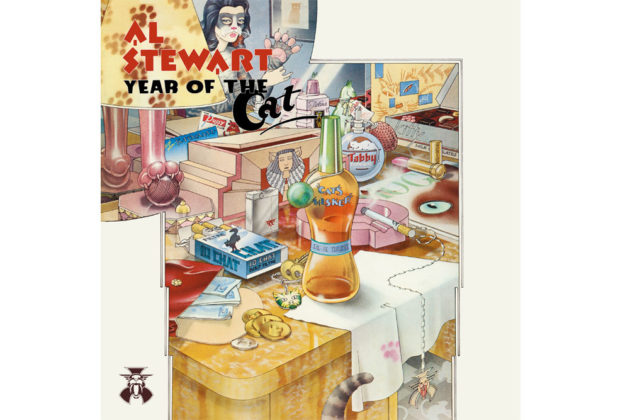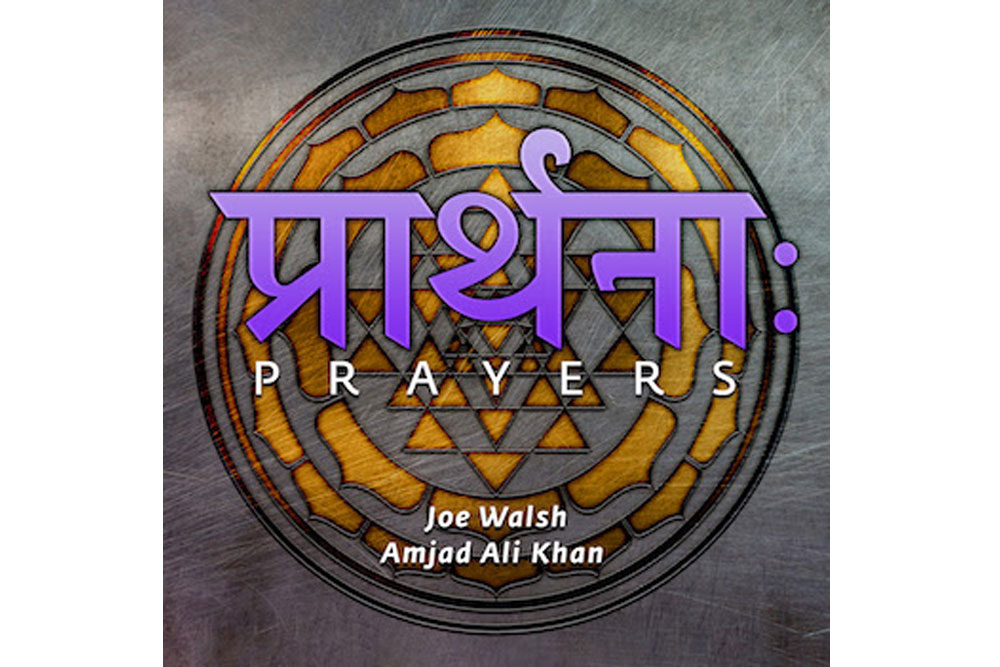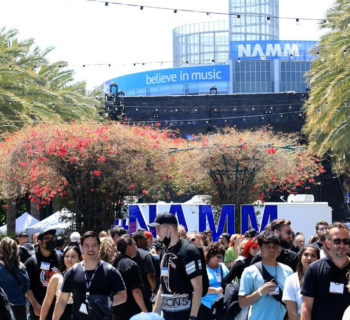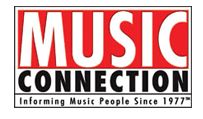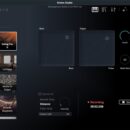Al Stewart’s 1976 album, Year of the Cat, received a 45th Anniversary release from Esoteric Recordings. The expanded 3-CD/1-DVD boxed set has been newly re-mastered for the first time from the original first-generation master tapes by Alan Parsons.
The new retail product incorporates an additional 10 bonus tracks drawn from previously unreleased live recordings made in Seattle at the Paramount Theatre in Seattle, Washington in October 1976, on Stewart’s Year of the Cat tour, and album session out-takes. There’s also an illustrated 68-page book with a new Al Stewart interview, a facsimile promotional poster and a set of four postcards.
Recorded in the early months of 1976 at Abbey Road studios (with some sessions and mixing taking place at Davlen Studios in Los Angeles), Year of the Cat was the seventh album by Stewart and was the second endeavor on which he collaborated with the celebrated producer Parsons.
Year of the Cat was a major commercial and critical success on its release, reaching #_ in the US, earning platinum status in March 1977. The “Year of the Cat” single was also a Top Ten hit in the States, establishing Stewart as a major artist.
The record was an album of immense musical inventiveness and creativity both in terms of Al Stewart’s song writing and the stunning and sophisticated production by Parsons. The album houses additional well-received songs as “On the Border,” “Lord Grenville,” “Midas Shadow,” “If It Doesn’t Come Naturally, Leave It,” “One Stage Before” and the classic title track.
"One of the coolest things about the 1970s is the way the pop song started to reach for new, more cinematic narrative shapes,” suggested writer and author Daniel Weizmann in a March 2021 email to me.
“It was almost like pop music was in a race to match the killer way that movies were evolving in the hands of directors like Scorcese, Allen, Kubrick, and others--toward the real. Part of that literary energy was down from Dylan and Blood on the Tracks of course, and the proliferation of rock opera also played its part, but AM-ready pop singles had a kind of heyday of storytelling in the '70s. Chapin's ‘Taxi,’ ‘Hotel California,’ ‘Baker Street,’ ‘Haitian Divorce,’ and so many other pop gems invested their lyrics with the psychic distance and the scene beats that great stories require. ‘Year of the Cat’ is one of the masterpieces.
“In a way, the song reminds me of Polanski's Chinatown,” offers Weizmann, a UCLA graduate, “because it tries to thread two sensibilities, old and new--the romantic spirit of Cole Porter, Irving Berlin, and the Gershwins, with the modern folksinger's sense of being lost in the world. Written in second-person, the lyrics mix Bogart and Lorre with watercolors and patchouli, the nostalgic ‘exotica’ of Casablanca and the mystic contemporary, and the economy of events is something to behold. It's like a four-volume Lawrence Durrel romance or The Sun Also Rises compacted into five moving minutes (technically 6:40 on the album, 4:38 on the single, but who's counting.)
“Without putting too fine a point on it, the story unfolds like a Zen parable about romantic love: Boy meets Girl, Boy chases Girl through an unnamed foreign square, Boy spends the night with Girl only to find he's lost his ticket home. To romance, Boy succumbs, snagged by fate, hypnotized by her embrace but also her embrace of temporariness. The catch is that all the while he knows deep down this romance is also fleeting--the mercury-quick Cat is the odd-man-out in Chinese zodiac years.
“There's more than meets the eye in this strange tale,” Daniel concludes. “The way I hear it, an older version of romantic love is being reconciled to the modern. You see, in the '60s, the whole idea of love went wide, communal, ironic, tainted by ambivalence and the reality principle, maybe more erotic but also less feeling. The Depression-era sensibility that drove Berlin and the Gershwins--the notion that the heart and heartbreak were the main thing worth singing about--ultimately wasn't useful once the affluent teenyboppers got ‘liberated.’ So they cordoned the romantic love song off for the Greatest Generation, who by the '70s were already nearing retirement, languishing in the Palm Springs sun listening to Perry Como and ‘The Look of Love.’ Great stuff, but it was music for older people. In its gallant way, songs like ‘Year of the Cat’ rescued the romantic song for a new generation in search of a love story that was modern and true.”
In 1976 I interviewed Stewart for the now defunct Melody Maker about Year of the Cat after I wrote his biography for Janus Records who released the LP in the US.
When the album achieved platinum album status I received a platinum LP for my services. Al came to my 27th birthday party. Also in attendance were Kevin Ayers and Roger Taylor of Queen.
Stewart was born in Glasgow, and moved from Scotland with his mother to the town of Wimborne, Dorset, England. In 2017 Al was given a Lifetime Achievement award at the BBC Radio 2 Awards by Tony Blackburn, who once played in a band with Al in Dorset.
Over the decades Stewart has recorded 19 studio albums and still tours on a regular basis.
His first recording, “The Elf,” came out in 1966 on Decca Records which included session man and guitarist Jimmy Page. Al emerged from the legendary British folk revival in the sixties and seventies and developed the combination of folk-songs with delicately woven tales of noted characters and events from history.
Stewart’s work addresses the French Revolution in “The Palace of Versailles,” Sir Richard Grenville and Amy Johnson in The Year of the Cat,” while US presidents William McKinley, Dwight Eisenhower and Calvin Coolidge are subjects in compositions.
In 2021 I interviewed Al Stewart again after a 45 year hiatus.
Q: In 1976 you had worked with Alan Parsons before, and he had experience engineering the Beatles’ Abbey Road and Let It Be at Abbey Road. I know you met the Beatles and John Lennon once let you play his guitar.
A: In going to Abbey Road, the first album we did there was Modern Times, the record before Year of the Cat. We did Modern Times which had some wonderful Tim Renwick guitar solos on it.
Working with Alan Parsons was really interesting because we had something in common, which had nothing to do with music. Which was go out to dinner and drink great bottles of wine, which was what we were doing in 1974. Around that time I had dinner with Alan and I happened to mention I was due to go into the studio and make another album. And I knew he was a hot producer and asked him to produce it. “All right” and we went back and discussed wine.
Q: Give me the run up to Year of the Cat. Your former manager Luke O’Reilly had a game plan regarding promotion on Modern Times which paved the way for subsequent Year of the Cat radio airplay on AM and FM radio stations.
A: Luke had been a disc jockey in Philadelphia. And he said “We’re going to tour America.” And I said “OK. Fine,” but he replied, “Not the way you think. We’re going to all the major cities in America and we’re gonna play. It doesn’t matter if you get three encores or if the crowd boos, because that’s not why we are there.” I replied, “Why are we going there then?” And he said “we’re going to every single radio station that we possibly can. We will arrive in the mid-afternoon, do a sound check, visit two radio stations, come back and do the gig, and then at midnight we’re going to more radio stations. That’s the only thing I’m interested in. You are going to meet every single program director and music director at every FM radio station we can get our hands on.” And that’s what we did and it paid off.
I remember talking to Fairport Convention, who mentioned they would play great shows in the States, and get an encore, but could not get radio airplay. And I told them “you gotta go there to the stations.” Modern Times got to number 30 in the album charts, we sold 150,000 copies. But I was invisible in England. They knew I was doing something but they didn’t know what. (laughs). Luke’s whole thing was working our butt off and going to radio stations.
Q: When you heard the first playback of Year of the Cat what did you think?
A: I thought I knew exactly what was gonna happen. I listened to the playback and I thought the album was a step forward from Modern Times. The songs were strong and the production was terrific. I had no expectations of AM airplay but we will get plenty of FM airplay. And I thought we could sell 250,000 copies. And if it did that I was going to be delirious and happy.
Janus Records said “we’re gonna release a single.” “Good! This is my seventh album and I’ve never had a hit single anywhere in the world.” And I suggested “Sand In Your Shoes,” the most commercial track on the album and it might be a hit. I was right. It was a hit in South Africa where I reached number six. (laughs). But they said “No. We’re gonna release “Year of the Cat,” we’re gonna do an edit and put it out as a single.” I thought, “That’s not gonna go anywhere. There was a reason I had it as the last track on the album. It’s too long and slow. Not commercial at all.” (laughs). That was my take on it. The album nosed its way up just outside the 20 at Christmas time.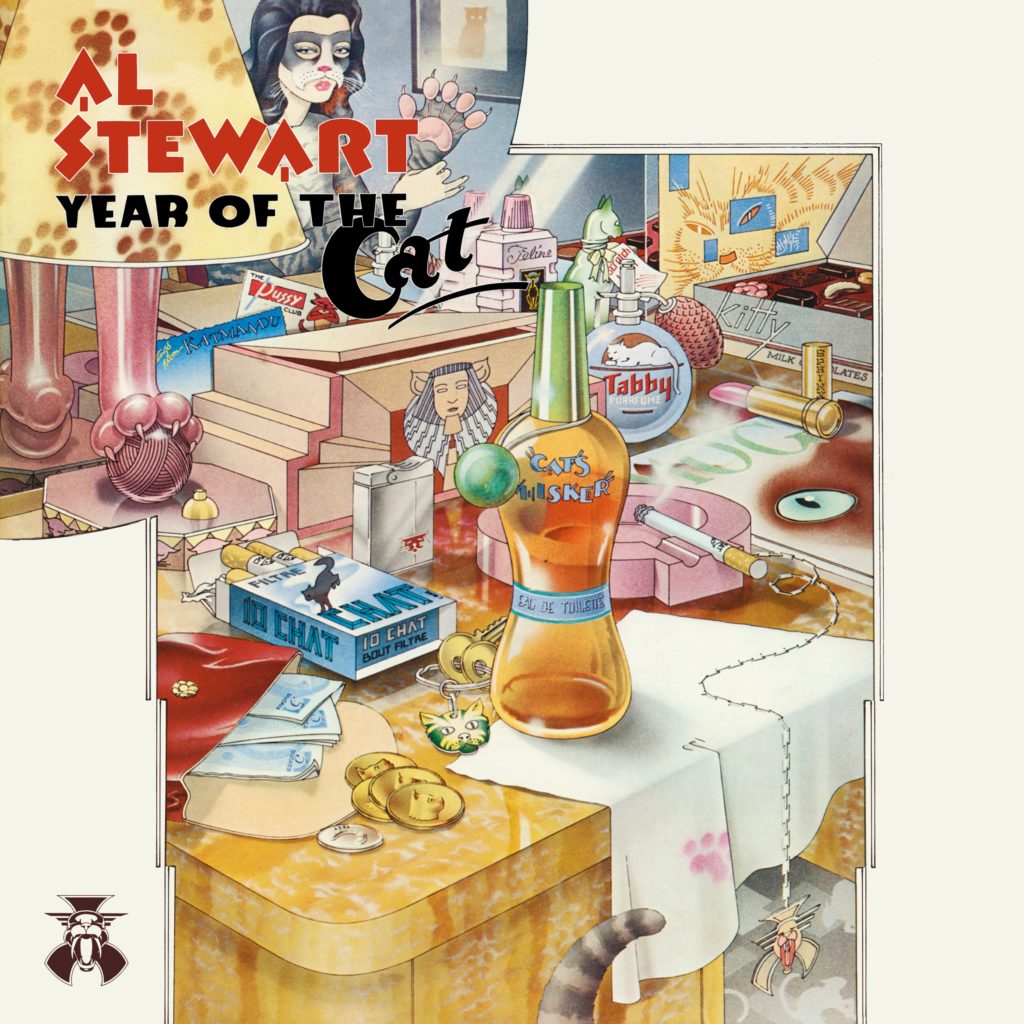
A: The Year of the Cat album cover brought us into your collection of songs.
A: Yes. Of course it was done by Hipgnosis, who did Pink Floyd and Led Zeppelin covers. Their way of working was that you gave them an acetate of the record and you went away. And some weeks later they would produce it and say “this is your cover,” most of the time it worked because they were really good. I loved the cover straight away. It just jumped out. All those cats and references…
Album covers in those days were very important. There’s a couple of albums I purchased just because of the cover. King Crimson’s In the Court of the Crimson King’ and the first Blondie LP. Very strong covers. You could almost look at an album cover and knew whether you’d like the record or not.
Q: I felt that the woman you described in “‘Year of the Cat” had west coast hippie allure and someone guided by astrology. I would imagine over the decades you have heard lots of comments about the recording.
A: I was never a hippie. But I did get a compliment later on from someone who was a hippie around that time, “Yeah…You were ahead of your time.” And I said “why?” “Well, we were all smoking dope 40 years ago and you were drinking fine wine. And now we’re all drinking wine.”
The best compliment I’ve got regarding “Year of the Cat,” not that I’ve ever really met him or know him was by Andrew Loog Oldham, he coined the phrase “it’s a forever kind of song.” And I think that is wonderful. I write songs long hand in an exercise book with a ballpoint pen. I do have a piano at my home.
Q: The 2021 Year of the Cat configuration also contains a live album from a date in October 1976. You’ve always employed stage banter when presenting your repertoire.
A: Actually, the longer I tour the more I tend to talk and tell stories. I’ve had nights where I’ve talked for at least one third of the show. Some of it has just become stand-up comedy. Because some of the songs are so heavy that it’s nice to have funny stories in between. And, of course, you accumulate funny stories as you go through your career. Every artist has them. So I like that aspect of it. I’m not just singing songs. I like giving the background of how the song was written and why. Like “Roads to Moscow.” I based it on Solzhenitsyn. It’s difficult to be funny about Solzhenitsyn but you can. (laughs). I write songs long hand in an exercise book with a ballpoint pen. I do have a piano at my home.
Q: You’ve been performing live for over half a century. Is one of the reasons for your success and making a living as an artist, attributed to your strengths as a songwriter?
A: Mainly because I was always a lyric writer. And rock ‘n’ roll is not about that. The other problem was, I looked in the mirror and I thought “you’re not Elvis.” Paul Simon actually said the same thing. (laughs). “Gotta find something else to do.”
You got to remember, my background is in rock ‘n’ roll. I drew upon all the early rockers. Little Richard, Eddie Cochran, Del Shannon, Jerry Lee Lewis and Fats Domino. I could play all the Duane Eddy tracks. That is what I grew up on.
When I left school at 17 I spent two years playing in rock bands. I came to the folk scene just because I was writing too many words for rock ‘n’ roll, when you played dance halls you would do “Twist and Shout” two or three times a night. People don’t really listen.
I saw Dylan in 1965 doing his acoustic tour. You got to remember that in those days it was the days of package tours. 5 bands. The Beatles, for example, played for 30 minutes maybe 35 minutes, tops. Their whole set.
And Dylan came on and played acoustic guitar and might have been nearly two hours. I did not think that was possible. I didn’t think that one person with an acoustic guitar could hold the attention of an audience for that amount of time. But it was effortless. He didn’t even bother to talk to the audience. He just played. And I thought, “My God! I’d never seen anything like that in my life. This opens up a wealth of possibilities.” At exactly that moment a folk club opened in the west end of London called Les Cousins. I got offered the job of running it.
Q: In 1965 and 1966 you served as the compere, master of ceremonies at the Les Cousins folk club on Greek Street in the Soho district of London, and played your tunes in that venue where Cat Stevens, Van Morrison, Roy Harper, Ralph McTell, Bert Jansch and Paul Simon did sets.
A: They had all-nighters that ran from midnight to 6:00 AM on Friday and midnight to 7:00 AM on Saturday.
So all of a sudden all of these people like Paul Simon, and later Jimi Hendrix used to come down after their gigs and get up and do guest spots. I briefly encountered Andrew Loog Oldham one evening there citing a 1964 recording he made with Kim Fowley for the Decca label under the name Bo and Peep. In 1965 I’m still trying to join a rock band at that point. I had an electric guitar. I actually auditioned for the Paramounts, and they turned into Procol Harum. And then I saw Bert Jansch. And I’d never seen anyone play the guitar like that. It was completely revolutionary. That was important.
Q: You then shared a London flat with Paul Simon in Dellow Street, Stepney.
A: And then of course, Paul Simon moves in. That was an earth-shaking event. I was running a folk club, even though I’m not really a folkie, and then Paul moves into a room next door to me. And I could hear him writing songs through the wall. And when you write a song you want someone to listen to it. Even though Paul thought I was probably the village idiot. (laughs). He would come out and play all his new songs. All of that is going on.
And then, to my amazement and shock, Paul had written his song “The Sounds of Silence,” [later known as “The Sound of Silence”] and the damn thing went to number one in America [in January 1966] while Paul was making like 20 pounds a night playing the English folk circuit at the time.
I remember going to a music publisher with Paul just before [remixed] “The Sounds of Silence” became a hit in America after the record producer Tom Wilson [in late summer 1965] added the electric instruments to the original “The Sounds of Silence” [1964] track [that was the original acoustic version cut in March, 1964 and issued on the debut Simon & Garfunkel Wednesday Morning, 3 A.M. released in October ’64 which was a commercial flop].
Paul needed some money and had a chat with the publisher he knew about selling some of his catalog for something like five thousand pounds. They passed. The company would have owned his early songs like “The Sounds of Silence.” He was damn lucky they said no. (Laughs).
Q: You did your first recording session on Jackson C. Frank’s 1965 debut LP Jackson C. Frank produced by Paul Simon at Levy’s Recording Studio in London. You played guitar on “Yellow Walls.”
A: Yes. I was the only one there besides Paul and Art. I still am asked in interviews about Jackson C. Frank and Nick Drake.
Q: During 1965 the Byrds and Bob Dylan really made a further impact on your musical direction.
A: When the Byrds’ released “Mr. Tambourine Man,” [June 1965] and Dylan did “Like a Rolling Stone,” [issued July 1965] I thought, “My God!” This folk rock thing was in the back of my mind as being interesting, but I thought it had no commercial applications whatsoever, and all of a sudden it’s the biggest thing in the world. And I thought, “That’s it. I’m going to be a folk rocker because that’s the future.”
In 1966 I saw Dylan and his group, later to be known as The Band, at the Royal Albert Hall. But I had a completely different take on it because I had been around rock bands and around sound systems. And so I knew the technical side of it.
The Royal Albert Hall had one of the worst P.A. systems imaginable. It was set up for political speeches. Winston Churchill made speeches there. That’s fine if the audience is sitting and listening and you’re talking into the microphone you can hear it. With an acoustic guitar you can still hear it. That’s fine. You put a rock band in the Royal Albert Hall and Dylan I think was using the house system. You couldn’t hear a word. It was totally underpowered. It was like if you had a rock band behind you and you’re singing through a transistor radio. And there was no way anybody could hear what was happening.
So it wasn’t that I didn’t think it worked, because I had his album Bringing It All Back Home and I knew that it would work with a band, but it just didn’t work with the sound systems of the day. They just weren’t powerful enough in the UK. And that I think is the problem. [A sound board audio tape by a hired engineer did record a pristine 1966 UK performance].
Q: In May 2015 you headlined the Royal Albert Hall in the UK with a program built around albums Past, Present and Future and The Year of the Cat repertoire. Tim Renwick, Peter White and Stuart Elliott who had played on the original recordings joined you for this event.
A: Yes. It was lovely.
When you tour all sorts of people show up. The last few years I’ve been working with a young band out of Chicago, none of them were born when Year of The Cat came out. And on our last gig on the last tour, Geoff Downes from the Buggles, Yes and Asia showed up. And my band knew how to play “Video Killed the Radio Star” so they lured Geoff down onto the stage and I think the audience was just shocked. (laughs), They sort of expected me to play ‘Lord Grenville.’”
I’ve also taken the opportunity to exhibit my 1976 interview with Al Stewart.
Coasting With Al
Harvey Kubernik, Melody Maker, 27 November 1976
AL STEWART is now enjoying greater success in America.
"At the moment," he says, "the West Coast particularly seems to be a stronghold. More things are happening now than they ever did in England. That has a lot to do with the image I had in England. I was thought of as a folk singer. No one ever wrote about "selling out" folk clubs. I did, but consequently you didn't read about it."
Stewart is now backed by an electric five-piece band, not for the first time. "Even on Love Chronicles I had a band," he remarks. "This move to electric isn't a new departure. It's something I've always done. I just think I'm doing it more effectively.
"Peter White plays guitar on the album and was with me on the last U.S. tour. Steve Chapman is on bass and was on the last tour but didn't play on Year of the Cat. Peter Robinson is on keyboards, and was recently with Shawn Phillips. I saw him across the road at Budget rent-a-car," he laughs.
"I asked him if he wanted to join the band. He didn't have any other commitments at the time and joined us. Mark Goldenberg is a fine lead guitar player.
"He was in the Eddie Boyd Band on MCA from Chicago. We auditioned 18 guitar players. We spread the word around we were looking, and he showed up and jammed on acoustic guitars with Peter White.
"We made a shortlist and gave them all records and sent 'em home to learn the solos. He did his homework and fits right in. He's a real find. Robin Lamble is the brother of Martin Lamble and plays drums. Martin played on Love Chronicles. Robin was in an English band called Byzantium.
"What we're trying to do is build a nucleus of musicians that we can draw on at any time. There's probably 20 people I've been in a band with in the last few years. A reservoir to dip into."
With Year of the Cat moving up the American charts and ticket sales prolific, did he feel more respected by the public in the United States?
"I haven't played in England for nearly two years. I know what did happen. The best way of looking at it was that I had Love Chronicles (MM Folk album of the year 1969), and I was getting a lot of good press.
"Then Zero She Flies and Orange were not as good, and consequently I received some bad press.
"After Past, Present, and Future I came here and never toured England with a good band. In England they have an image of me which is completely out of date. This tour we'll probably be able to turn most heads around. I was never in the folk ranks. I played acoustic guitar, but on every record I've made I had a band."
Stewart is a broad-ranging writer who draws his inspiration even from literary sources like Vonnegut and Solzhenitsyn. Some have felt his material too sophisticated for mass audiences. "First of all," he replies, "I write for myself and try to make it the best I possibly can. That's my obligation.
"The things I write can be appreciated on so many levels. There are things on my album, and especially on Year of the Cat that you can appreciate, just for the lead guitar work.
"I don't think it's important or necessary for everybody to be able to take in all the details. There are references in the songs that I don't expect every radio programmer to pick up on."
His recent Roxy Theatre performance was selected from his last three albums; Past, Present, and Future, Modern Times, and Year of the Cat.
"No I'm no more ashamed of them than you of an essay you wrote when you were 15. Do you know what I mean? Therefore, the past is not something I'm ashamed of, but as a writer you should make an effort to improve as you go along.
"I might do some of the older things as we go along. We're thinking for England that we might learn 'Bedsitter Images.’ I wouldn't do it on a regular basis.
"The set we do now focuses on the three albums. Sometimes we include 'Nostradamus', which we didn't get a chance to perform in L.A. I think Past, Present, and Future was the complete turning-point on everything I've done.
"It was so much better than anything I did before. It automatically made it obsolete. From that point of view what I was doing before was an apprenticeship. That's how I view it."
The evening's highlight at the Roxy was “Roads To Moscow,” with Stewart as musical narrator to a montage of film clips. “I like Bowie a lot, and went to see him at Wembley. I don't know if he influenced me, combining the little theatre with the music. The back projection cost about £3,000. We could have bought a whole set of string synthesizers for that. It was Luke's (Luke O'Reilly, Al's manager) idea.
"The slides are historically accurate. The show starts off electric and dips down to an acoustic segment and back up to electric again. 'Roads To Moscow' is getting a tremendous response every time we do it."
Year of the Cat is Stewart's most accessible album. "Alan Parsons cleaned up the production totally," he admits.
"This album has a very thick sound, where something like Love Chronicles had a very thin sound. Love Chronicles still sounds fine on a set-down record player, but that's the way it was made.
"Musically though, there is nothing I can do change the Al Stewart identity. What the Al Stewart identity hinges and depends on is my peculiar approach of using literature and history as backdrops in my songs. As long as I continue to do that, that will be my identity, much more than whether I use saxophones on record."
The Year of the Cat concerns a "California type," according to Al, who mentioned to him that "it was the year of the cat..." Says Stewart: "It's a 1960s phrase, as opposed to something said today. It's about getting involved, even though you know it's just a temporary thing. I imagined a hippie girl into astrology.
"What I like about the song is the guy knows he can't stay in Casablanca forever, but he's content to stay as long as he can: the resignation that this isn't the love of his life, but he'll make the best of it.
“'Lord Grenville' details an eccentric sea captain who took on 53 Spanish galleons. 'On The Border' is about the failure now of old solutions. "The border mentioned is a personal border civilization has brought to us. ‘Midas Shadow' is about money. It's about the kind of guy that seems to attract success, someone who is surrounded by money and the things it buys. He always has money, and then suddenly it disappears.
“‘Sand In Your Shoes' is close to a mid-sixties Dylan composition. I've always enjoyed The Band. I've never done one of those organ-sounding tunes. George Harrison plays guitar on the cut.
"'If It Doesn't Come Naturally, Leave It' is my rock and roll song," he chirps.
'Broadway Hotel' traces a romance between a lady and desk clerk who checks her into a hotel.
"'On Stage Before' deals with reincarnation. The title song closes the album. Modern Times sounds like it was done quickly. We took longer recording this one and it sounds like it."
© Harvey Kubernik, 1976
During 2020 Harvey’s 19th book, Docs That Rock, Music That Matters was published, featuring interviews with D.A. Pennebaker, Chris Hegedus, Albert Maysles, Murray Lerner, Morgan Neville, Dr. James Cushing, Curtis Hanson, Michael Lindsay-Hogg, Andrew Loog Oldham, Dick Clark, Ray Manzarek, John Densmore, Robby Krieger, Travis Pike, Allan Arkush, and David Leaf, among others.
In 2020 Harvey Kubernik was a Consultant on the 2-part documentary Laurel Canyon: A Place in Time directed by Alison Ellwood. Kubernik is currently working on a documentary about Rock and Roll Hall of Fame member singer/songwriter Del Shannon.
This decade Harvey was filmed for the currently in-production documentary about former Hollywood landmark Gold Star Recording Studio and co-owner/engineer Stan Ross produced and directed by Brad Ross and Jonathan Rosenberg. Brian Wilson, Herb Alpert, Richie Furay, Darlene Love, Mike Curb, Chris Montez, Bill Medley, Don Randi, Hal Blaine, Shel Talmy, Don Peake, Kim Fowley, Johnny Echols, Gloria Jones, Carol Kaye, Marky Ramone, David Kessel and Steven Van Zandt have participated).
Harvey served as Consulting Producer on the 2010 singer-songwriter documentary, Troubadours directed by Morgan Neville. The film was shown at the 2011 Sundance Film Festival in the documentary category. In March 2011, PBS-TV broadcast the movie in their American Masters series.
Harvey is also spotlighted for the 2013 BBC-TV documentary Bobby Womack Across 110th Street, directed by James Meycock. Womack, Bill Withers, Ronnie Wood of the Rolling Stones, Damon Albarn of Blur, the Gorillaz and Antonio Vargas are featured.
In 2019 Harvey Kubernik was an interview subject in the Chris Sibley & David Tourje-directed short documentary entitled John Van Hamersveld: Crazy World Ain’t It. Van Hamersveld designed the iconic Endless Summer visual image and album covers for the Beatles, the Rolling Stones, Jefferson Airplane, Grateful Dead, the Beach Boys, the Kaleidoscope, and Blondie.
In 2019, Harvey appeared as a screen interview for director Matt O’Casey on his BBC4-TV digital arts channel Christine McVie, Fleetwood Mac’s Songbird. The cast includes Christine McVie, Stan Webb of Chicken Shack, Mick Fleetwood, Stevie Nicks, John McVie, Christine’s family members, Heart’s Nancy Wilson, Mike Campbell, Neil Finn, and producer Richard Dashut. Debut broadcast was in September 2020.
Harvey during 2019 was taped for director Matt O’Casey on his BBC4-TV digital arts channel documentary Christine McVie, Fleetwood Mac’s Songbird. The cast includes Christine McVie, Stan Webb of Chicken Shack, Mick Fleetwood, Stevie Nicks, John McVie, Heart’s Nancy Wilson, Mike Campbell, Neil Finn, and producer Richard Dashut. The premiere broadcast was in September 2020.
Kubernik was lensed as a screen interview subject for director/producer Neil Norman’s GNP Crescendo documentary, The Seeds: Pushin’ Too Hard. Jan Savage and Daryl Hooper of the Seeds participated along with Bruce Johnston of the Beach Boys, Iggy Pop, Kim Fowley, Jim Salzer, the Bangles and Johnny Echols of Love, photographer Ed Caraeff, and Mark Weitz of the Strawberry Alarm Clock. Miss Pamela Des Barres supplied the narration. Norman’s documentary is scheduled for debut airing on television during 2021.

